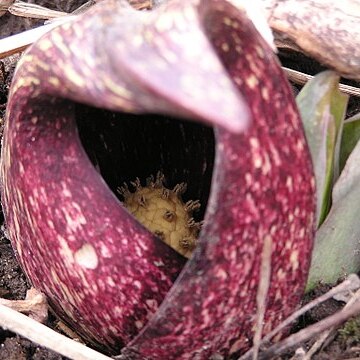Herbs, wetland or subterrestrial. Rhizomes vertical. Leaves appearing after flowers, several, erect, clustered, erect; petiole equal to or shorter than blade; blade green to dark green, simple, not peltate, oblong to ovate, base truncate or cordate, apex acute to obtuse; primary veins lateral, branching apically. Inflorescences: peduncle partly underground, much shorter than leaves, apex not swollen; spathe yellowish green to dark red-purple, usually spotted or striped with both, open only apically at maturity, enclosing spadix; spadix ovoid to globose. Flowers bisexual; perianth present. Fruits embedded in enlarged spongy spadix, dark purple-green to dark red-brown. Seeds 1, mucilage absent. x = 15.
Fls perfect, covering the subglobose spadix, this subtended and mostly enclosed by a fleshy, ovate, pointed spathe; perianth of 4 erect, connivent tep; stamens 4; ovaries buried in the spadix, unilocular, uniovulate; style stout, 4-angled, subulate; seeds embedded in the enlarged, spongy spadix, covered by the persistent perianth and style; herb from a thick rhizome; spathe partly underground, with very short peduncle, the lvs appearing later and becoming very large. Monotypic.

